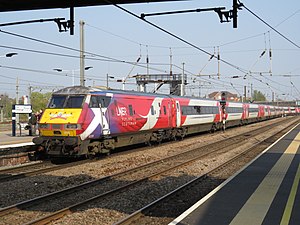| British Rail DVT | |
|---|---|
 London North Eastern Railway Mk4 DVT at Peterborough | |
| In service | 1989 – present |
| Manufacturer | Mark 3: British Rail Engineering Limited Mark 4: Metro-Cammell |
| Family name | |
| Constructed | 1988 - 1990 |
| Number built |
|
| Number in service |
|
| Number preserved |
|
| Number scrapped |
|
| Fleet numbers |
|
| Operators | |
| Specifications | |
| Car length | 18.83 m (61 ft 9 in) |
| Width | 2.71 m (8 ft 11 in) |
| Height | 3.88 m (12 ft 9 in) |
| Maximum speed | 125 mph (201 km/h) (Mark 3) 140 mph (225 km/h) (Mark 4) |
| Weight | 43.7 t (43.0 long tons; 48.2 short tons) |
| Braking system(s) | Air |
| Track gauge | 1,435 mm (4 ft 8+1⁄2 in) standard gauge |
A Driving Van Trailer (DVT) is a British purpose-built control car railway vehicle that allows the driver to operate with a locomotive in push-pull formation from the opposite end of a train. A key benefit of operating trains with DVTs is the requirement for fewer locomotives; for example, a second locomotive would otherwise have to join at the other end of the train after arrival at terminal stations to lead the train's onward journey.
The Mark 3 DVT was originally designed and produced by British Rail Engineering Limited (BREL) during the late 1980s and early 1990s. Unlike many other control cars, such as the Mark 2 DBSO, the DVT visually resembles a locomotive, specifically Class 90 for the 82/1 Mark 3 series and Class 91 for the 82/2 Mark 4 series; thus when the train is operating in push mode, it does not appear to be travelling backwards. The vehicles do not have any passenger accommodation due to health and safety rules in place at the time of construction that prohibited passengers in the leading carriages of trains that run faster than 100 miles per hour (160 km/h).[citation needed] Historically, it was believed that a train would be unstable at high speeds unless pulled from the front; however, extensive testing and the experience of high speed trains with central power cars, such as the Advanced Passenger Train (APT) and the Eurostar, have since altered this view.
The later-built Mark 4 DVT was specifically developed to work with the new Mark 4 carriages of the InterCity 225 on the East Coast Mainline while the Mark 3 DVT was built to work with the Mark 2 and Mark 3 carriages which then comprised the InterCity rolling stock on the West Coast Main Line. A planned Mark 5 DVT was never produced. Following the Privatisation of British Rail, various private sector train operators have opted to use DVTs in their services. In some cases, such as Wrexham & Shropshire's services between London Marylebone and Wrexham General using Mark 3s and Class 67 diesel locomotives, the DVTs required modification to work with new types of locomotives. Other operators have opted to have their DVTs outfitted with diesel generators or even traction apparatus, the latter case resulting in the experimental Class 19 locomotive.
© MMXXIII Rich X Search. We shall prevail. All rights reserved. Rich X Search
